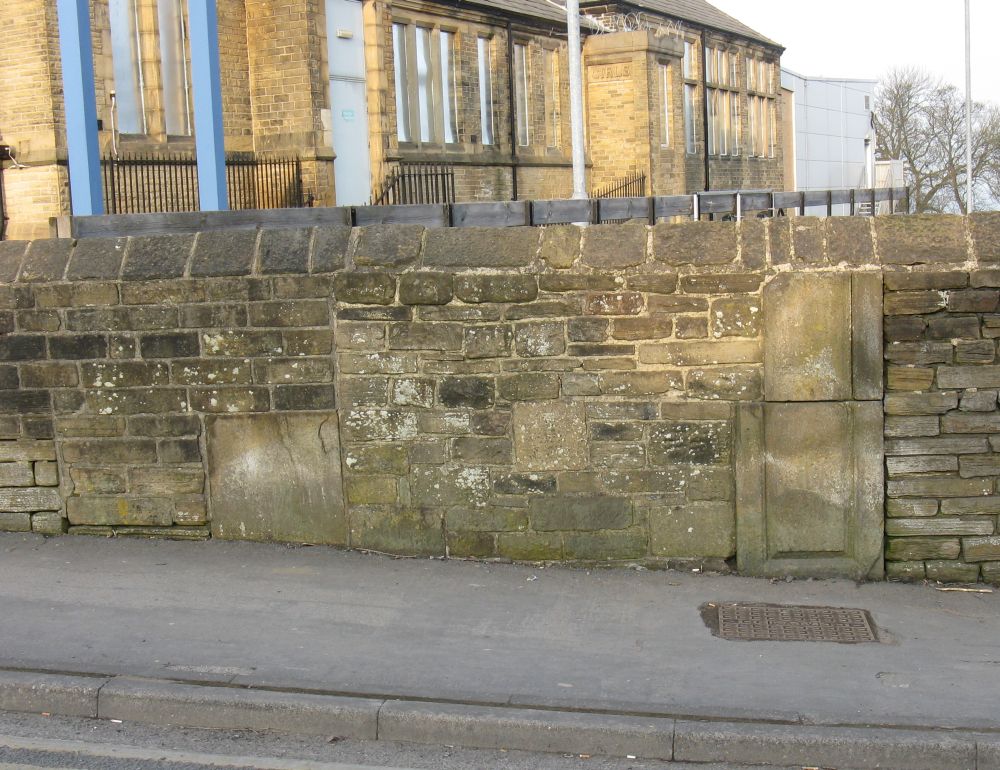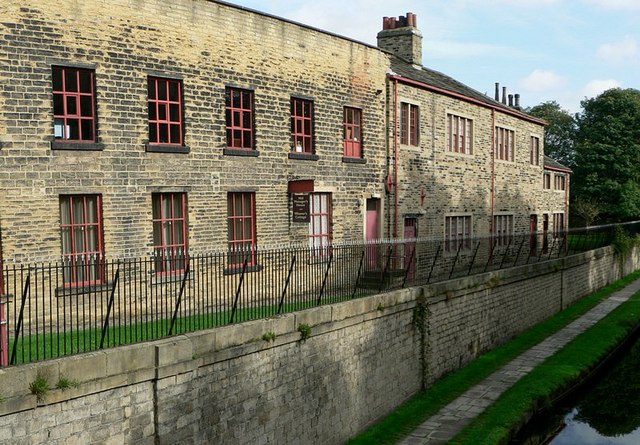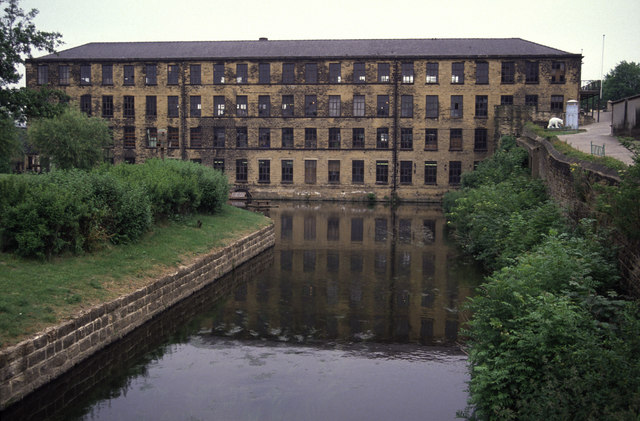|
Esholt Sewage Works Railway
Esholt Sewage Works Railway was a standard gauge works railway constructed in 1910 to serve a sewage works in Esholt, West Yorkshire, England. The works were built to remove wool-grease and other wastes from effluent coming out of the many mills of the Bradford woollen district. At its peak, the railway extended to of track served by 11 locomotives, as well as a shorter section of narrow gauge railway served by three engines. Trains were employed to remove solid waste from the site; several of the engines were converted to run on oil derived from recovered wool-grease. The railway was closed completely in 1977, but the sewage works continues to operate. Origins Bradford was a major force in woollen products in the 19th and into the 20th century; nearly 20% of the world's wool production was being handled at Bradford. A branch of the Leeds and Liverpool Canal extended up Bradford Dale from Shipley to a point near to where Bradford Forster Square railway station is today. ... [...More Info...] [...Related Items...] OR: [Wikipedia] [Google] [Baidu] |
Leeds And Liverpool Canal
The Leeds and Liverpool Canal is a canal in Northern England, linking the cities of Leeds and Liverpool. Over a distance of , crossing the Pennines, and including 91 locks on the main line. The Leeds and Liverpool Canal has several small branches, and in the early 21st century a new link was constructed into the Liverpool docks system. History Background In the mid-18th century the growing towns of Yorkshire, including Leeds, Wakefield and Bradford, were trading increasingly. While the Aire and Calder Navigation improved links to the east for Leeds, links to the west were limited. Bradford merchants wanted to increase the supply of limestone to make lime for mortar and agriculture using coal from Bradford's collieries and to transport textiles to the Port of Liverpool. On the west coast, traders in the busy port of Liverpool wanted a cheap supply of coal for their shipping and manufacturing businesses and to tap the output from the industrial regions of Lancashire. Inspired by ... [...More Info...] [...Related Items...] OR: [Wikipedia] [Google] [Baidu] |
Midland Railway
The Midland Railway (MR) was a railway company in the United Kingdom from 1844. The Midland was one of the largest railway companies in Britain in the early 20th century, and the largest employer in Derby, where it had its headquarters. It amalgamated with several other railways to create the London, Midland and Scottish Railway at grouping in 1922. The Midland had a large network of lines emanating from Derby, stretching to London St Pancras, Manchester, Carlisle, Birmingham, and the South West. It expanded as much through acquisitions as by building its own lines. It also operated ships from Heysham in Lancashire to Douglas and Belfast. A large amount of the Midland's infrastructure remains in use and visible, such as the Midland main line and the Settle–Carlisle line, and some of its railway hotels still bear the name '' Midland Hotel''. History Origins The Midland Railway originated from 1832 in Leicestershire / Nottinghamshire, with the purpose of serving the needs o ... [...More Info...] [...Related Items...] OR: [Wikipedia] [Google] [Baidu] |
Closed Railway Lines In Yorkshire And The Humber
Closed may refer to: Mathematics * Closure (mathematics), a set, along with operations, for which applying those operations on members always results in a member of the set * Closed set, a set which contains all its limit points * Closed interval, an interval which includes its endpoints * Closed line segment, a line segment which includes its endpoints * Closed manifold, a compact manifold which has no boundary Other uses * Closed (poker), a betting round where no player will have the right to raise * ''Closed'' (album), a 2010 album by Bomb Factory * Closed GmbH, a German fashion brand * Closed class, in linguistics, a class of words or other entities which rarely changes See also * * Close (other) * Closed loop (other) * Closing (other) * Closure (other) * Open (other) Open or OPEN may refer to: Music * Open (band), Australian pop/rock band * The Open (band), English indie rock band * ''Open'' (Blues Image album), 1969 * ' ... [...More Info...] [...Related Items...] OR: [Wikipedia] [Google] [Baidu] |
Hunslet Engine Company
The Hunslet Engine Company is a locomotive-building company, founded in 1864 in Hunslet, England. It manufactured steam locomotives for over 100 years and currently manufactures diesel shunting locomotives. The company is part of Ed Murray & Sons. History The early years 1864–1901 The company was founded in 1864 at Jack Lane in Hunslet by John Towlerton Leather, a civil engineering contractor, who appointed James Campbell (son of Alexander Campbell, a Leeds engineer) as his works manager. The first engine was completed in 1865. It was ''Linden'', a standard gauge delivered to Brassey and Ballard, a railway civil engineering contractor as were several of the firm's early customers. Other customers included collieries. This basic standard gauge shunting and short haul "industrial" engine was to be the main-stay of Hunslet production for many years. In 1871, James Campbell bought the company for £25,000 (payable in five instalments over two years) and the firm remained ... [...More Info...] [...Related Items...] OR: [Wikipedia] [Google] [Baidu] |
Eccleshill, West Yorkshire
Eccleshill is an area, former village, and ward within the City of Bradford Metropolitan District Council in the county of West Yorkshire, England. The ward population of Eccleshill is 17,540, increasing at the 2011 Census to 17,945. Eccleshill is a more or less completely residential urban area with very little open space although there is substantial open land directly to the east. The origins of the name Eccleshill are uncertain. At the time of the ''Domesday Book'' the area was known as Egleshill either meaning 'eagles hill' or perhaps named after a Saxon landlord called Aikel or Eckil—alternatively it could mean Ecclesiastical Hill. History In Roman times the Eccleshill area was crossed by two lanes. One lane was along what is now Norman Lane and the other to Apperley Bridge down the road now known as Bank. After the Norman Conquest the lands of Eccleshill were given to William, Earl of Warren. In 1274 ownership of lands passed to the Sheffields and in 1407 to the B ... [...More Info...] [...Related Items...] OR: [Wikipedia] [Google] [Baidu] |
Bradford Industrial Museum
Bradford Industrial Museum, established 1974 in Moorside Mills, Eccleshill, Bradford, United Kingdom, specializes in relics of local industry, especially printing and textile machinery, kept in working condition for regular demonstrations to the public. There is a Horse Emporium in the old canteen block plus a shop in the mill, and entry is free of charge. History of the site Moorside Mills was a textile factory built by John Moore in 1875 for worsted spinning which grew into a medium-sized factory employing around 100 people. The mill which was originally steam powered was converted to electricity in the early 20th century. It was bought by Clifford and Arnold Wilson in 1908 who installed a mill engine built by Cole, Marchent and Morley in 1910. The high demand for worsted used for military uniforms during the World War I saw numerous expansions to the factory including the addition of two extra floors and a clock tower which was erected as a war memorial in 1919. In 1929 th ... [...More Info...] [...Related Items...] OR: [Wikipedia] [Google] [Baidu] |
City Of Bradford Metropolitan District Council
City of Bradford Metropolitan District Council is the local authority of the City of Bradford in West Yorkshire, England. It is a metropolitan district council, one of five in West Yorkshire and one of 36 in the metropolitan counties of England, and provides the majority of local government services in Bradford. Since 1 April 2014 it has been a constituent council of the West Yorkshire Combined Authority. History In 1974, City of Bradford Metropolitan District Council was created to administer the newly formed metropolitan borough. The county borough of Bradford was merged with the Borough of Keighley, the Urban Districts of Baildon, Bingley, Cullingworth, Denholme, Ilkley, Shipley and Silsden, along with part of Queensbury and Shelf Urban District and part of Skipton Rural District by the Local Government Act 1972. The Council, which is based at Bradford City Hall in Centenary Square, governs the whole metropolitan district. The city was granted the right on 18 September 1907 to ... [...More Info...] [...Related Items...] OR: [Wikipedia] [Google] [Baidu] |
Yorkshire Water
Yorkshire Water is a water supply and treatment utility company servicing West Yorkshire, South Yorkshire, the East Riding of Yorkshire, part of North Lincolnshire, most of North Yorkshire and part of Derbyshire, in England. The company has its origins in the Yorkshire Water Authority, one of ten regional water authorities created by the Water Act 1973, and privatised under the terms of the Water Act 1989, when Yorkshire Water plc, the parent company of the Yorkshire Water business, was floated on the London Stock Exchange. The parent company was Kelda Group in 1999. In February 2008, Kelda Group was bought by a consortium of infrastructure funds. It is regulated under the Water Industry Act 1991. Area The company's area includes West Yorkshire, South Yorkshire, the East Riding of Yorkshire, part of North Lincolnshire, most of North Yorkshire and part of Derbyshire. The area is adjoined on the north by that of Northumbrian Water, on the west by United Utilities, on the south ... [...More Info...] [...Related Items...] OR: [Wikipedia] [Google] [Baidu] |
Armley
Armley is a district in the west of Leeds, West Yorkshire, England. It starts less than from Leeds city centre. Like much of Leeds, Armley grew in the Industrial Revolution and had several mills, one of which houses now the Leeds Industrial Museum at Armley Mills. Armley is predominantly and historically a largely working class area of the city, still retains many smaller industrial businesses, and has many rows of back-to-back terraced houses. It sits in the Armley ward of Leeds City Council and Leeds West parliamentary constituency. In 2022, statistics released by West Yorkshire Police revealed Armley and New Wortley had the second highest crime rate in Leeds after Leeds city centre. Etymology First attested in the Domesday Book of 1086 as ''Ermelai'', the name ''Armley'' comes from Old English. The second element is from Old English ''lēah'' ('open space in a wood'). The origin of the first element is less clear, but thought to come from an otherwise unattested Old E ... [...More Info...] [...Related Items...] OR: [Wikipedia] [Google] [Baidu] |
Leeds Industrial Museum At Armley Mills
The Leeds Industrial Museum at Armley Mills is a museum of industrial heritage located in Armley, near Leeds, in West Yorkshire, Northern England. The museum includes collections of textile machinery, railway equipment and heavy engineering amongst others. The Grade II* listed building housing the museum was once the world's largest woollen mill. The current structures were built in 1805 by Benjamin Gott and closed as a commercial mill in 1969. They were taken over by Leeds City Council and reopened as a museum of industrial heritage in 1982. It is located between the Leeds and Liverpool Canal and the River Aire and accessed from Canal Road or Milford Place. It is part of Leeds Museums & Galleries, which also includes Leeds Art Gallery, Leeds City Museum, Leeds Discovery Centre, Thwaite Mills, Lotherton Hall, Temple Newsam, Abbey House Museum and Kirkstall Abbey. Location Armley Mills lie on the south bank and an island in the River Aire. The mill is above sea level, at a po ... [...More Info...] [...Related Items...] OR: [Wikipedia] [Google] [Baidu] |
Hudswell Clarke
Hudswell, Clarke and Company Limited was an engineering and locomotive building company in Jack Lane, Hunslet, Leeds, West Yorkshire, England. History The company was founded as Hudswell and Clarke in 1860. In 1870 the name was changed to Hudswell, Clarke and Rodgers. There was another change in 1881 to Hudswell, Clarke and Company. The firm became a limited company in 1899. In 1862, soon after the company had been formed, they were given the initial design work on William Hamond Bartholomew's compartment boats for the Aire and Calder Navigation. The choice of the company may have been influenced by the fact that Bartholomew, the chief engineer for the Navigation, and William Clayton, one of the founders of Hudswell and Clarke, both lived on Spencer Place in Leeds. They produced at least one of the prototype Tom Pudding compartments, but did not get the main contract for their production once the design work had been done. As steam locomotive builders, like many of the sm ... [...More Info...] [...Related Items...] OR: [Wikipedia] [Google] [Baidu] |
Thackley
Thackley is a small suburb near Bradford, West Yorkshire in England. The village is loosely bordered by the village of Idle to the south, to the west by the West Royd area of Shipley and elsewhere by the Leeds and Liverpool Canal. Thackley is the northernmost part of Bradford south of the River Aire. History Prehistory An archaeological project during 2009 funded by the Heritage Lottery Fund, revealed the site in Buck Wood of an enclosure that was in use as a settlement from Neolithic to post-Roman times. The work, undertaken by the Friends of Buck Wood led by a professional archaeologist, showed that in the past a substantial boundary wall had been built of local unworked stone, enclosing a natural terrace of level ground now surrounded by woods. This formed an oval enclosure, roughly 82 m by 78 m in size. The remains of a quern stone for grinding grain was found within this central area, as was a single cup marked carved rock. Leading away from the enclosur ... [...More Info...] [...Related Items...] OR: [Wikipedia] [Google] [Baidu] |








